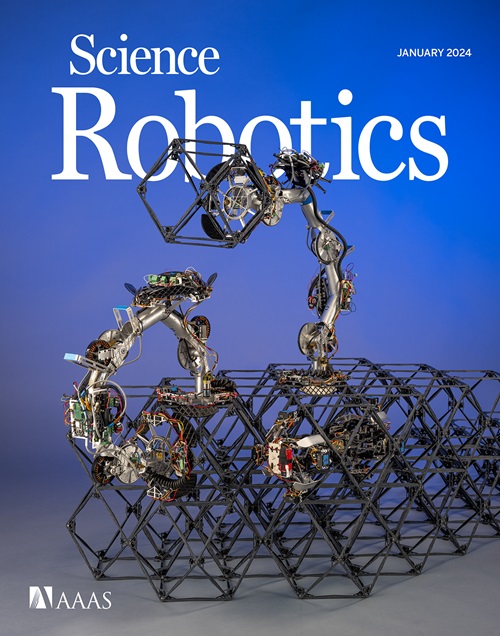Self-organizing nervous systems for robot swarms
IF 26.1
1区 计算机科学
Q1 ROBOTICS
引用次数: 0
Abstract
We present the self-organizing nervous system (SoNS), a robot swarm architecture based on self-organized hierarchy. The SoNS approach enables robots to autonomously establish, maintain, and reconfigure dynamic multilevel system architectures. For example, a robot swarm consisting of n independent robots could transform into a single n–robot SoNS and then into several independent smaller SoNSs, where each SoNS uses a temporary and dynamic hierarchy. Leveraging the SoNS approach, we showed that sensing, actuation, and decision-making can be coordinated in a locally centralized way without sacrificing the benefits of scalability, flexibility, and fault tolerance, for which swarm robotics is usually studied. In several proof-of-concept robot missions—including binary decision-making and search and rescue—we demonstrated that the capabilities of the SoNS approach greatly advance the state of the art in swarm robotics. The missions were conducted with a real heterogeneous aerial-ground robot swarm, using a custom-developed quadrotor platform. We also demonstrated the scalability of the SoNS approach in swarms of up to 250 robots in a physics-based simulator and demonstrated several types of system fault tolerance in simulation and reality.

机器人群的自组织神经系统
我们提出了自组织神经系统(SoNS),这是一种基于自组织层次结构的机器人群架构。SoNS 方法使机器人能够自主建立、维护和重新配置动态多级系统结构。例如,由 n 个独立机器人组成的机器人群可以转变为一个 n 个机器人的 SoNS,然后再转变为多个独立的小型 SoNS,其中每个 SoNS 都使用临时的动态层次结构。利用 SoNS 方法,我们证明了感知、执行和决策可以通过局部集中的方式进行协调,而不会牺牲可扩展性、灵活性和容错性等优点,而这些正是研究蜂群机器人技术的通常目的。在几个概念验证机器人任务(包括二进制决策和搜索救援)中,我们证明了 SoNS 方法的能力大大推进了蜂群机器人技术的发展。这些任务是利用一个定制开发的四旋翼平台,通过一个真实的异构空地机器人群来完成的。我们还在基于物理的模拟器中演示了 SoNS 方法在多达 250 个机器人群中的可扩展性,并在模拟和现实中演示了几种类型的系统容错。
本文章由计算机程序翻译,如有差异,请以英文原文为准。
求助全文
约1分钟内获得全文
求助全文
来源期刊

Science Robotics
Mathematics-Control and Optimization
CiteScore
30.60
自引率
2.80%
发文量
83
期刊介绍:
Science Robotics publishes original, peer-reviewed, science- or engineering-based research articles that advance the field of robotics. The journal also features editor-commissioned Reviews. An international team of academic editors holds Science Robotics articles to the same high-quality standard that is the hallmark of the Science family of journals.
Sub-topics include: actuators, advanced materials, artificial Intelligence, autonomous vehicles, bio-inspired design, exoskeletons, fabrication, field robotics, human-robot interaction, humanoids, industrial robotics, kinematics, machine learning, material science, medical technology, motion planning and control, micro- and nano-robotics, multi-robot control, sensors, service robotics, social and ethical issues, soft robotics, and space, planetary and undersea exploration.
 求助内容:
求助内容: 应助结果提醒方式:
应助结果提醒方式:


